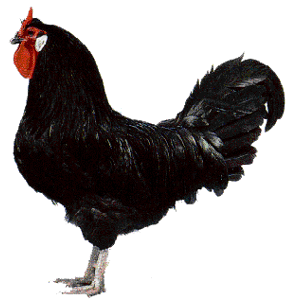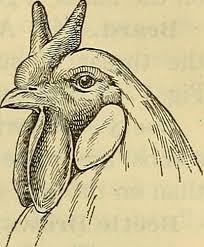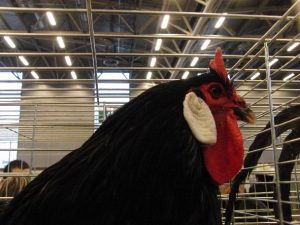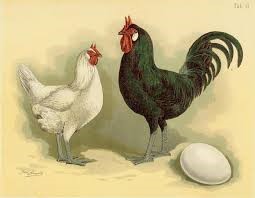
Breed Overview
Breed History
La Fleche Chickens have been bred since the 16th Century in the Pays de la Loire region in the Loire Valley of North West France. This is an area covered with rich pastures and vineyards and the River Loire at its center. The breed is named after the town of La Fleche in the Valley of La Sarthe, around 31 miles (50km) from the banks of the Loire River. The town of La Fleche is located equidistant between the towns of Le Mans (famous for motor racing) and Angers, famous for wine and liquers. La Fleche was famous for producing magnificent large capons (castrated cocks), petit poussin and poulardes (force fed pullets) that were eaten in Paris and sold in Anjou markets. These birds are also sometimes known as ‘Fowl of Le Mans’, as the breed originated in Le Mans several hundred years before arriving in La Fleche.
La Fleche Chickens are available as both Standards and Bantams. With Standards recognised in the USA and UK in 1874. Bantam La Fleche chickens were bred in Germany.
The Standard are a medium size dual-purpose ‘meat and eggs’ chicken with black plumage and an unusual ‘V’ shaped red comb. One theory is that as this unusual V shaped comb, which looks like an arrow head, is where the name La Fleche comes from. In French La Fleche means ‘the arrow’! This unusual bright red ‘V’ comb also led to the bird’s nickname of ‘The Devil Bird’, as the shiny black plumage combined with upright red comb looking like ‘devil horns’.
La Fleche Facts
The Bantam has exactly the same looks and proportions as the large chicken, simply in a much smaller size.
La Fleche chickens are mostly kept by backyard chicken enthusiasts for their looks and good rate of egg production.
As a rare ornamental breed La Fleche can be bought from a few breeders in both the USA and UK. There are now more La Fleche breeders emerging across as interest in this breed builds.
The meat of La Fleche chickens is considered to be one of the best tasting in the whole of France. For this reason the birds were highly sought after and the controversial ‘force feeding’ methods were widely adopted in France to rapidly increase the birds’ weight. Back in the 16th Century La Fleche chickens in France would have been kept as free range ‘grazier fowl’ foraging in orchards and vineyards. They are exceptional foragers and enjoy a diet of fallen fruit, insects, weeds and grubs.
Further breed history
La Fleche were bred from crossing Black Spanish, Crevecoeur and Minorca blood lines, as evident by its high carriage, active nature, large white lobes, V-shaped comb and the trace of crest on its head, which crops out on specimens of other French breeds.
In the 19th Century a large number of La Fleche chickens were exported from France to breeders in the USA, but unfortunately the breed was not hardy enough to flourish. La Fleche failed to thrive in the colder East Coast and Middle States climates of the USA which experience prolonged freezing winter temperatures. La Fleche is however very good at tolerating hot weather.
Size & Weight
The breed is deceptive in size, with tight fitting black feathers, it is heavier than it looks, with Standard males weighing over 8 pounds (3.6 kg). La Fleche resemble Spanish chickens, with the exception of their comb. La Fleche hens lay large white eggs, with an average weight of 2.1 ounces (60 gm), usually from March to October.
Breed standards state that mature Standard males weigh up to 8.8 pounds (4 kg). Standard hens will typically weigh up to 6.6 pounds (3 kg), mature Bantam hens around 1.7 pounds (.7 kg), and bantam cocks around 2.2 pounds (1 kg).
Eggs
Size
Eggs are large in size weighing around 2.1 ounces (60gms), with bantams laying medium size eggs weighing 1.2 ounces (35 gms).
Color
Eggs are usually pure white or cream colored, rarely with speckles
Production per year
Up to 190 eggs per year, for first four years.
When do they start laying eggs?
Chicks mature slowly and hens start laying from 6 months onwards.
La Fleche Characteristics
Temperament / Are they good as pets?
La Fleche chickens can make good pets if raised by hand as chicks and you have a very large backyard. However, breeders often describe them as being noisy, flighty, standoffish and at times wild. These birds love to fly and explore, so high fencing is essential to contain them safely and pens need a wired top.
If hand raised as chicks La Fleche can be tame, but not necessarily well-behaved when young and are prone to crazy, flighty behavior! Im thinking a high fence is required are you…!
La Fleche hens are considered to be good mothers, generally get along quite well together, and rarely go broody. One cockerel for around 5 hens is a good ratio.
La Fleche has a reputation as a highly productive egg layer, but requires good quality feed daily. They love to actively forage outside ‘far and wide’ in warmer months and require large spaces for this.
How do I tame La Fleche chickens?
The best way to tame a chicken is to handle it when it is still young; this gets your chickens used to people. If you have older chickens that need taming, try feeding them out of your hand regularly. La Fleche chickens can become tame, but tend to generally ignore humans (unless offering food) and have a flighty nature. High containment fencing is necessary as these birds like nesting in trees. A good idea to train them to regularly return to the chicken coop each night, is to feed them before dusk.
How many do I need to buy?
2 chickens are the absolute minimum you need for a flock, we recommend around 5 as a small flock number.

How much space do they need?
Standard birds are medium/large and don’t like being confined in small chicken coops. Ideally 6 square feet minimum per mature bird in a coop. In a run around 30 square feet minimum per bird, with good outside access to prevent boredom. La Fleche Chickens love being outside exploring and foraging for food. These chickens are very good fliers, so high -level containment fencing is necessary or you will see your chickens far away roosting in high trees or taken by predators!
Will they mix with my other chickens?
La Fleche is not an aggressive bird, but it is ‘flighty’, and not considered a good breed for a small backyard. Most breeders keep La Fleche as free range chickens requiring significant space to roam. La Fleche will get along well with other breeds of chickens, as long as there is no other male cockerel to cause aggressive behaviour. It is important they are not too closely confined and there is adequate room to explore and prevent boredom.
Appearance
These can be stunning looking birds in their jet-black shiny plumage and are much admired for their good looks. The black feathers may also have an attractive blue/green shine. La Fleche have long wattles, white earlobes and the plumage is nearly always black with gray/blue/black legs and feet. La Fleche chickens have white skin and the tail is well developed with many ornamental feathers. Other plumage colours sometimes seen are blue, white and cuckoo.
Along with the unusual red ‘V’ shaped comb, La Fleche possess a good set of wings, which they frequently use to fly about.
Plumage cover is good over the whole body, no skin is visible, but the feathers don’t provide good cold weather insulation.

Feeding
What should I feed them?
When you first get your chicks home you should feed them growers mash. It has a higher percentage of protein (19{cfcd481556a8b43fba6af451761032bd323e94372a0c1e607}) and is refined so that it can be easily ingested.
You should feed them growers mash up until 6 weeks. Then they should be fed chicken pellets which is just feed in pellet form, this has between 15-16{cfcd481556a8b43fba6af451761032bd323e94372a0c1e607} protein.
At 18 weeks your chickens need more nutrients to help with egg production. My advice is slowly start feeding them layers mash or pellets which has around 16{cfcd481556a8b43fba6af451761032bd323e94372a0c1e607} protein.
Chickens will need access to fresh drinking water all day long! They will prefer cool drinking water, no one is quite sure why maybe it’s a prehistoric throwback. It is important to have the feed and water at the proper height for all birds in the pen.
Ideally feed and water should be at back level. If the water is too low down, chickens may scratch litter into it and the water will go bad quickly.
Your chickens also need grit to help with egg production. So make sure there is always some within easy access for them at all times.
La Fleche are excellent foragers and will supplement their feed intake by hunting outside. Thet will eat insects, slugs, snails, seeds and bugs to eat.
How much should I feed them?
La Fleche are medium sized birds, and have healthy appetites, eating anywhere between 4 oz (113g) and 6 oz (170g) a day. On average breeders feed their chickens 5 oz (140g) a day.
Start by feeding them this and then adjust the weight of feed around how much they consume. You can leave the feed in a feeder for them to eat whenever they please or you can give them set meal times.
Your chickens also need grit to help with egg production, so make sure there is always some in easy reach for them at all times.
What can’t they eat?
Chocolate and beans are the two main foods that shouldn’t be eaten by chickens. The phytohemagglutinin in beans can lead to fatalities and the theobromine in chocolate can cause heart problems. Moldy food that has bad bacteria in it should not be fed to chickens as it can make them very unwell. For this reason, it is illegal to feed your chickens leftovers in the UK.

What do I need to keep chickens?
The most essential item you need to keep chickens is a coop. This should ideally be 0.5 m2 or 6 square feet per chicken. Their run needs 30 square feet (2.7 m2) per chicken. In the coop they should have a perch to sleep on and a wooden laying box for their eggs.
You should invest in a sunken fence to go over and around the coop to keep them safe at night. Find a water bowl which they can’t stand in or push over and place it in the shade. This is so the water doesn’t get too warm. I’ve found feed and water for La Fleche are best placed off the ground. Place at around the ‘back’ height of the bird. Raised feed and water bowl holders are easily obtained.
